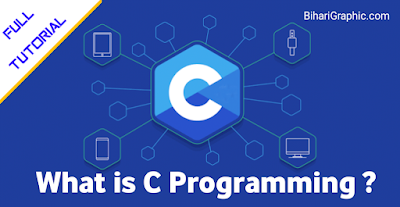What is C Programming | How to learn C programming full tutorial 2023
C is a high-level, general-purpose, procedural programming language that was designed to be used for system programming, developing operating systems and embedded systems. It was first developed by Dennis Ritchie at Bell Labs in the early 1970s and has since become one of the most widely used programming languages in the world.
Here’s a comprehensive guide to learning C programming:
- Introduction: Learn about the history of C programming, its characteristics, and why it is widely used today.
- Getting Started: Set up your development environment, install a compiler, and create your first C program.
- Variables and Data Types: Learn about the various data types used in C, including integers, characters, and floating-point numbers, and how to declare and initialize variables.
- Operators: Learn about the various arithmetic, relational, and logical operators used in C, and how to use them to perform calculations and make decisions in your programs.
- Control Flow: Learn about the if-else statement, the switch statement, and the looping constructs in C, and how to use them to control the flow of execution in your programs.
- Arrays and Strings: Learn about arrays, strings, and how to manipulate them in C.
- Functions: Learn about functions, how to declare and call them, and how to pass parameters and return values.
- Pointers: Learn about pointers, how to declare and initialize them, and how to use them to manipulate memory dynamically.
- Structures and Unions: Learn about structures, unions, and how to use them to group data elements of different data types.
- File Input/Output: Learn about file input/output in C, and how to read from and write to files.
- Advanced Topics: Learn about dynamic memory allocation, recursion, and other advanced topics in C.
- Practice: Write and debug a variety of C programs to reinforce your understanding of the language.
History of C Programming
C was developed at Bell Labs in the early 1970s. The language was designed and implemented by Dennis Ritchie and was used for system programming, developing operating systems, and embedded systems.
The development of C was influenced by several programming languages, including B, BCPL, and Unix Assembly. The primary goal of the language was to create a portable and efficient language that could be used to write system software, especially the Unix operating system.
C was first introduced in 1972 and quickly gained popularity due to its simplicity, efficiency, and versatility. It was used to develop the Unix operating system and several other popular operating systems, including Linux and Windows.
The popularity of C continued to grow throughout the 1980s and 1990s, and it became one of the most widely used programming languages in the world. Today, C remains one of the most popular programming languages, and it continues to be widely used for system programming, developing operating systems, and embedded systems.
In 1983, the American National Standards Institute (ANSI) standardized the language, which led to the development of the C89 (ANSI C) standard. The C89 standard was later updated in 1999 to create the C99 standard, which added several new features to the language.
Setup Environment
Here’s let’s see how to set up your development environment, install a compiler, and create your first C program:
- Development Environment: You can use any text editor to write your C programs. Some popular text editors include Notepad++, Sublime Text, and Visual Studio Code.
- Compiler: To run C programs, you need a compiler that converts the source code into machine-readable code. Some popular C compilers include GCC (GNU Compiler Collection), Clang, and Microsoft Visual C++.
- Installing a Compiler: You can download and install a compiler for your operating system. For example, GCC is pre-installed on most Linux distributions, and you can download and install it on Windows and MacOS.
- Creating Your First C Program: To create your first C program, follow these steps:
#include
int main()
{
printf("Hello, World!");
return 0;
} - Save the file with a .c extension (e.g. firstprogram.c)
- Open a terminal or command prompt and navigate to the directory where the file is saved.
- Compile the program by typing the following command: gcc firstprogram.c -o firstprogram
- Run the program by typing the following command: ./firstprogram
This program will print “Hello, World!” on the screen. Congratulations, you have just created and run your first C program!
This is just a general outline, and there is a lot more to learn in each of these areas. You can start by reading books, online tutorials, and watching video tutorials to gain a solid understanding of the language. You should also practice coding and working on projects to apply what you have learned.

